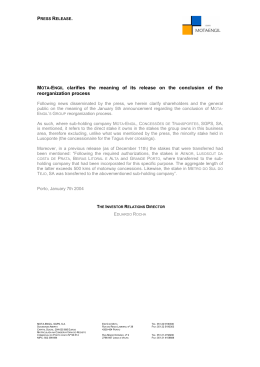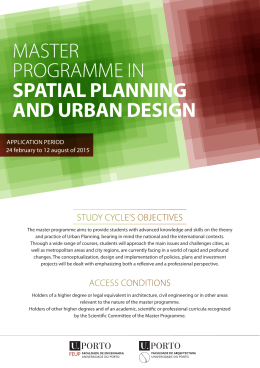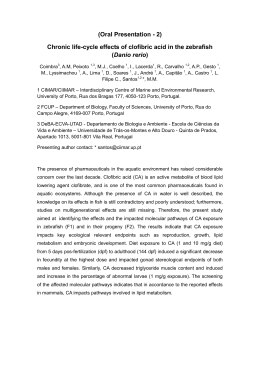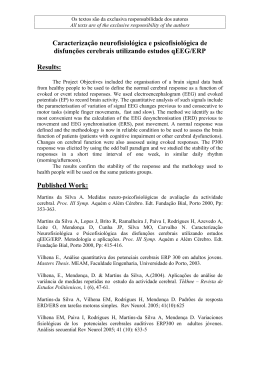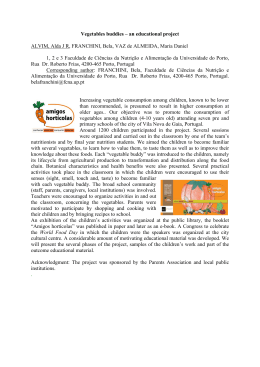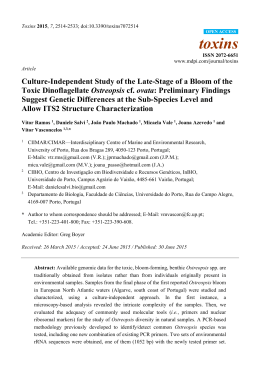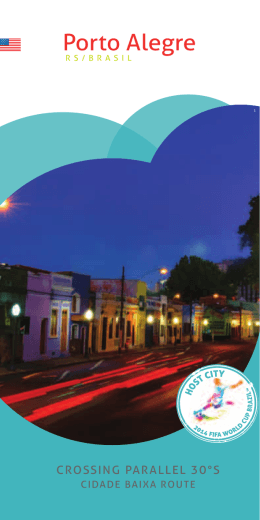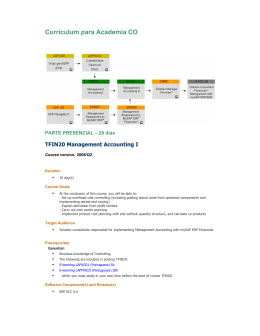Intensive Summer School (40 hours) 7 to 12 of September 2015 Acquisition, processing and analysis of EEG signal Aims of the Course: - Introduction to EEG and ERP applied to the study of cognitive and affective processes. - Acquisition of electrophysiological data of brain activity. - Signal processing. - Statistical analysis of the data. All the modules will have a laboratorial handson component. Language: English Basic knowledge of statistics required. Venue: Faculty of Psychology and Educational Sciences, University of Porto. Pre-registration: Until 31 of May 2015 (limited to 20 participants). Registration form Scientific Coordination : João Marques Teixeira, MD, PhD Fernando Barbosa, PhD Fernando Ferreira-Santos, PhD Pedro R. Almeida, PhD available at: http:// www.fpce.up.pt/ labpsi/summerschool/ Registration will be confirmed by 30 of June 2015 Course Fee: €300 (including all lunches) Laboratory of Neuropsychophysiology http://www.fpce.up.pt/labpsi Faculty of Psychology and Educational Sciences of the University of Porto Rua Alfredo Allen 4200-135 Porto, Portugal Tel: +351 226079700 Fax: +351 226079725 E-mail: [email protected] Porto, 7-12 of September, 2015 IV CAN – 4th Cognitive and Affective Neurophysiology Summer School: Acquisition, processing and analysis of EEG signal Preliminary Information booklet General information: The Cognitive and Affective Neurophysiology Summer School is organized by the Laboratory of Neuropsychophysiology of the University of Porto. For information about our lab, please visit our website, http://www.fpce.up.pt/labpsi/. Location: The summer school will take place at the Faculty of Psychology and Education Sciences of the University of Porto (in Portuguese: Faculdade de Psicologia e de Ciencias da Educacao da Universidade do Porto – FPCE-UP) Google Maps: http://goo.gl/maps/prtD8 How to get here? By Air: The closest airport is Porto Airport - Francisco Sá Carneiro: http://www.ana.pt/en-US/Aeroportos/porto/Porto/Pages/Homepage-Porto.aspx By Metro (Tram): The D Line (yellow) connects 'Pólo Universitário' and 'Gaia', crossing the central station 'Trindade', where it has connection with Lines A (blue), B (red) and C (green). Leaving at the 'Pólo Universitário' station you are at FPCE-UP. For more information, see http://www.metrodoporto.pt/en/. By Bus: Bus lines (Route planner: http://www.itinerarium.net/wizard.aspx?ul=en-us): Stop at: Igreja de Paranhos: 54 (AV.ALIADOS - PADRÃO MOREIRA) Stop at: Rua Dr. Manuel Laranjeira: 38 (CAMPANHÃ - HOSP.S.JOÃO), 204 (HOSP.S.JOÃO - FOZ Mercado), 300 (CIRCULAR AV.ALIADOS - HOSP.S.JOÃO) e 301 (CIRCULAR SÁ DA BANDEIRA - HOSP.S.JOÃO) By Car: The best way to find FPCE-UP is to follow the signs to “Paranhos / Hospital de São João”. Coming from the VCI: take the 'Paranhos / Hospital' exit off the freeway and stay to the right lane in the traffic lights at the 'Igreja de Paranhos' crossing. Turn right at the lights to the Rua do Dr. Manuel Pereira da Silva (street). A few yards further, turn on the first street to the left (where the Metro station of 'Polo Universitário' is located). You will find FPCE-UP to your left in that street. Coming from Estrada da Circunvalação (EN12): go to 'Hospital de S. João' and, at the traffic lights, turn to the 'IPO - Instituto Português de Oncologia' (street: Rua António Bernardino Almeida). Go straight and turn left just before the street becomes a two-way street. Then keep going until you find FPCE-UP on your right side. Duration: The course will take place between 7 (Monday) and 12 (Saturday) of September of 2015. The course duration will be 40 hours in total. Faculty: Professors João Marques-Teixeira (MD, PhD), Fernando Barbosa (PhD), Fernando Ferreira-Santos (PhD), and Pedro R. Almeida (PhD) are the scientific coordination team of the course. 2 Proposed Schedule: Monday 7-Sep 09:00 09:30 10:00 10:30 11:00 11:30 12:00 12:30 13:00 13:30 14:00 14:30 15:00 15:30 16:00 16:30 17:00 09:30 10:00 10:30 Opening and 11:00 Introduction 11:30 to EEG 12:00 12:30 13:00 13:30 Lunch 14:00 14:30 15:00 15:30 Introduction 16:00 to ERP 16:30 17:00 17:30 Tuesday 8-Sep Wednesday 9-Sep Thursday 10-Sep Friday 11-Sep Lab safety and hygiene; Issues in EEG data collection Signal processing (1) Signal processing (2); ERP analysis (time domain) Statistical analysis Lunch Lunch Lunch Lunch Practicum: EEG data collection Practicum: signal processing Practicum: signal processing Practicum: statistics Saturday 12-Sep Thematic seminar Lunch All lunches are included in the course (you will be provided with lunch coupons). A session for short participant presentations (5-10 mins.) may be scheduled, pending confirmation of the number of presentations. On Friday we will organise a social dinner and outing for those who are interested. This event is not included in the course fees. Details will be provided during the week. 3 Detailed Programme: 1. Introduction to the EEG/ERP techniques in Cognitive and Affective Neuroscience 1.1. Electroencephalography (EEG) 1.1.1. History 1.1.2. Main discoveries and applications, EEG rhythms 1.2. Principles of electricity (and very light notes on mathematical analysis) 1.3. Neurophysiological basis of the EEG signal 1.4. Event-related potentials (ERP) 1.4.1. History and technical definition 1.4.2. ERP components: definition and overview 1.4.2.1. Definition, classification, nomenclature, quantification 1.4.2.2. Overview of the main components 1.5. Technical basis of EEG/ERP 1.5.1. Laboratory setting and recording equipment 1.5.2. From the physical signal to the digital time-series 1.5.2.1. Sensors, amplification, analog-to-digital conversion 1.5.2.2. Sampling frequency, Nyquist-Shannon Theorem 2. Collecting EEG data 2.1. Ethical guidelines and lab safety and hygiene 2.2. Electrode positioning systems, montages, reference 2.3. Software for recording and processing EEG/ERP data 3. Electrophysiological signal processing (using the freely available EEGLAB software) 3.1. Introduction to time series analysis 3.2. Digital filters 3.3. Baseline correction 3.4. Linear trend correction 3.5. Event/response conditioning 3.6. Removal/correction of artifacts 3.7. Channel interpolation, downsampling 3.8. Averaging and grand-averaging 3.9. Quantification of ERPs in the time domain 3.10. Advanced EEG/ERP analyses (short overview) 4. Statistical analysis of results 4.1. Parametric statistical techniques (mean differences and analysis of variance) 4.1.1. The sphericity problem 4.1.2. The multiple comparisons problem 4.2. Classical ERP component approach vs. mass-univariate approach/SPM 4 Bibliography -- Fundamental references: Luck, S. J. (2014). An introduction to the event-related potential technique (2nd ed.). Cambridge, MA: MIT Press. [See website for free materials: http://mitpress.mit.edu/books/introduction-event-related-potentialtechnique-1] Luck, S. J., & Kappenman, E. S. (2012). The Oxford Handbook of Event-related potentials. New York: Oxford University Press. Niedermeyer, E., & Lopes da Silva, F. H. (2005). Electroencephalography: Basic principles, clinical applications, and related fields (5th ed.). Philadelphia, PA: Lippincott Williams & Wilkins. Bibliography -- Introductory references: Andreassi, J. L. (2000). Psychophysiology: Human behavior & physiological response (4th ed.). Mahwah, NJ: Lawrence Erlbaum. Carretie, L. (2009). Psicofísiologia. Madrid: Piramide. [in Spanish] Fabiani, M., Gratton, G., & Federmeier, K. D. (2007). Event-related brain potentials: Methods, theory, and applications. In J. T. Cacioppo, L. G. Tassinary, & G. G. Berntson (Eds.), Handbook of Psychophysiology (3rd ed., pp. 85-119). New York: Cambridge University Press. Jackson, A. F., & Bolger, D. J. (2014). The neurophysiological bases of EEG and EEG measurement: A review for the rest of us. Psychophysiology. doi:10.1111/psyp.12283 Keil, A., Debener, S., Gratton, G., Junghöfer, M., Kappenman, E. S., Luck, S. J., Luu, P., Miller, G. A., & Yee, C. M. (2014). Committee report: Publication guidelines and recommendations for studies using electroencephalography and magnetoencephalography. Psychophysiology, 51, 1-21. doi:10.1111/psyp.12147 [Free access] Picton, T. W., Bentin, S., Berg, P., Donchin, E., Hillyard, S. A., Johnson, R. et al. (2000). Guidelines for using human event-related potentials to study cognition: Recording standards and publication criteria. Psychophysiology, 37, 127-152. doi: 10.1111/1469-8986.3720127 [Available from SPR: http://www.sprweb.org/articles/Picton00.pdf] Putnam, L. E., Johnson, Jr., R., & Roth, W. T. (1992). Guidelines for reducing the risk of disease transmission in the psychophysiology laboratory. Psychophysiology, 29, 127-141. doi: 10.1111/j.14698986.1992.tb01676.x [Available from SPR: http://www.sprweb.org/articles/Putnam92.pdf] Bibliography -- Advanced references (note that these will not be addressed in the present course): Cacioppo, J. T., Tassinary, L. G., & Berntson, G. G. (Eds.) (2007), Handbook of Psychophysiology (3rd ed.). New York: Cambridge University Press. Handy, T. C. (Ed.) (2004). Event-related potentials: A methods handbook. Cambridge, MA: MIT Press. Michel, C. M., Murray, M. M., Lantz, G., Gonzalez, S., Spinelli, L., & Grave de Peralta, R. (2004). EEG source imaging. Clinical Neurophysiology, 115, 2195-2222. doi:10.1016/j.clinph.2004.06.001 Nunez, P. L., & Srinivasan, R. (2006). Electric fields of the brain: The neurophysics of EEG (2nd ed.). New York: Oxford University Press. Sanei, S., & Chambers, J. A. (2007). EEG signal processing. Chichester: John Wiley & Sons. 5
Download


